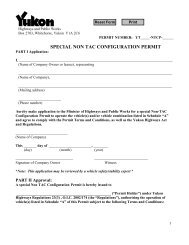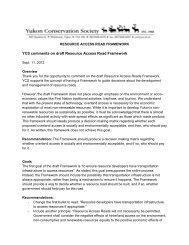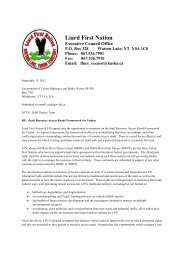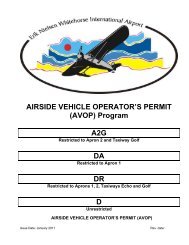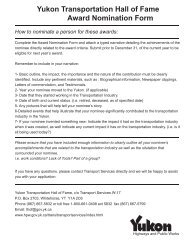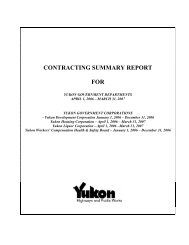Overweight Vehicle Single Trip Permit Information
Overweight Vehicle Single Trip Permit Information
Overweight Vehicle Single Trip Permit Information
Create successful ePaper yourself
Turn your PDF publications into a flip-book with our unique Google optimized e-Paper software.
VEHICLE WEIGHTSNon TAC configurationsSome equipment such as heavy haul or speciality equipment may not conform to the standard configurationsfound in Schedule 2 of the Highways Regulations.Any equipment that does not conform to the minimum interaxle spacing requirements set out in HighwaysRegulations, Section 14 shall in accordance with Highways Regulations, Section 15, have the axle group weightreduced 500 kg for every 0.1 m or portion there of that is less than the minimum spacing established inHighways Regulations, Section 14.Non TAC configuration will be dealt with on an individual basis. A carrier must apply for a special Non TACconfigurations permit and if granted comply with all the conditions of the permit. The permit will set outallowable weights per axle/axle group and overall weights allowed.MINIMUM INTERAXLE SPACING REQUIREMENTSIn order for a unit to be able to haul to the legal axle weights of these regulations, certain minimum inter-axlespacings are required.Highways Regulations, Section 14(a) <strong>Single</strong> axle to single axle, tandem axle group or tridem axle group, 3.0 metres(b) Tandem axle group to tandem axle group, 5.0 metres,(c) Tandem axle group to tridem axle group, 5.5 meters.(d) Tridem axle group to tridem axle group, 6.0If spacings are less than the minimum in Highways Regulations, Section 14 then a reduction of 500 kgs forevery 1/10 th of a meter applies, as per Highways Regulations, Section 15For Example:Legal Weights5,500 17,900 10,000 17,900 10,0003 1.5 2.6 5.5 1.5 2.7With the reduction this becomes31.52.65.51.52.75,500 Combined 25,900 26,400Reduction of 4/104X500 = 2000 kgReduction of 3/103X500 = 1500 kgYou would charge overweight above these combined weights. Also it is important to remember that neitheraxle can exceed the legal even if allowed
Determining maximum weights allowed on axles that are below minimum spacing requirements.Taking the example above where the legal weight on the drivers plus the single axle has been reduced from27,900 kgs to 25,900 kgs.• On a Tandem to a <strong>Single</strong> Axle combination or a tandem to tandem combination you would calculate themaximum allowed by multiplying the reduced weight 25,900 X 1.2 = 31,080 which would be the maximumweight allowed.• On a Tridem to a Tandem or a <strong>Single</strong> Axle you would calculate by Multiplying the reduced weight X 1.15to get the maximum weight allowed.On the <strong>Permit</strong> you would enter these combined weights as a single group weight. For example 25,900 wouldcover legal and 31,080 would cover maximum for the above example and these are the weights that would beentered – 17,900 and 10,000 would not appear on the permit unless the unit was overweight on one set of axles.Then it would be whichever is greater as it is with all permits.




